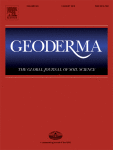View Item
- xmlui.general.dspace_homeCentros Regionales y EEAsCentro Regional Buenos Aires SurEEA Cuenca del SaladoArtículos científicosxmlui.ArtifactBrowser.ItemViewer.trail
- DSpace Home
- Centros Regionales y EEAs
- Centro Regional Buenos Aires Sur
- EEA Cuenca del Salado
- Artículos científicos
- View Item
Diffusivity and sorptivity determination at different soil water contents from horizontal infiltration
Abstract
Determination of soil hydraulic properties under non-saturated conditions is crucial in order to describe soil water dynamics in the field. The objectives of this work were: i- to determine soil water diffusivity (D) as a function of soil moisture with a simple lab set-up, based on Whisler et al. (1968) methodology, from soil moisture profiles obtained using capacitive sensors in three contrasting soils from Argentinean Pampas Region; and ii- to obtain a
[ver mas...]
Determination of soil hydraulic properties under non-saturated conditions is crucial in order to describe soil water dynamics in the field. The objectives of this work were: i- to determine soil water diffusivity (D) as a function of soil moisture with a simple lab set-up, based on Whisler et al. (1968) methodology, from soil moisture profiles obtained using capacitive sensors in three contrasting soils from Argentinean Pampas Region; and ii- to obtain a function that allows to determine sorptivity (S) values in the whole moisture range from diffusivity data. Additionally, horizontal infiltration data was used to obtain hydraulic conductivity function (K (h)) through inverse parameterization using HYDRUS 1-D. Horizontal infiltration was performed in order to determine D and S at different soil water content in 15 repacked columns from three different textured soils (loam, silty loam and sandy loam). The results indicate that the new approach is a suitable methodology for D (θ) and S (θ) determination. D values measured using the proposed laboratory setup ranged between 1 × 10−5 and 1.67 cm2 s−1, showing an exponential dependence with soil water content (r2 > 0.85). S values for different soil water contents ranged between 0.078 and 0.14 cm s−1/2. The highest value of S corresponded to the lowest soil water content, remaining practically constant in a large range of soil water content, and abruptly decreasing near saturation toward zero. The sandy loam soil showed higher values of D at saturation (D0) and total sorptivity (S0), as compared with the loam and silty loam soils. In conclusion, it was possible to determine D (θ) using a simple and robust setup, based on Whisler et al. (1968) method. Additionally, the proposed setup represents a simple way to measure soil S (θ) from horizontal infiltration, and to obtain K(h) functions through inverse parameterization.
[Cerrar]

Author
Villarreal, Rafael;
Lozano, Luis Alberto;
Melani, Esteban;
Salazar, María Paz;
Otero, María Florencia;
Soracco, Carlos Germán;
Fuente
Geoderma 338 : 88-96 (March 2019)
Date
2019-03-15
Editorial
Elsevier
ISSN
0016-7061
1872-6259
1872-6259
Formato
pdf
Tipo de documento
artículo
Palabras Claves
Derechos de acceso
Restringido
 Excepto donde se diga explicitamente, este item se publica bajo la siguiente descripción: Creative Commons Attribution-NonCommercial-ShareAlike 2.5 Unported (CC BY-NC-SA 2.5)
Excepto donde se diga explicitamente, este item se publica bajo la siguiente descripción: Creative Commons Attribution-NonCommercial-ShareAlike 2.5 Unported (CC BY-NC-SA 2.5)

